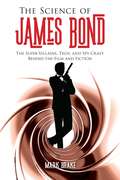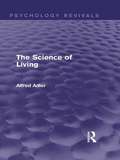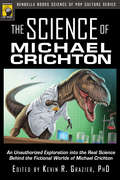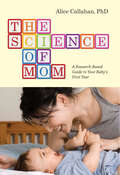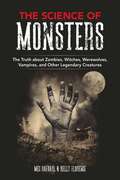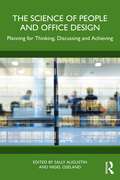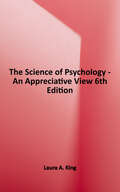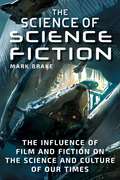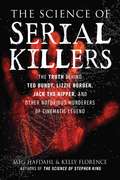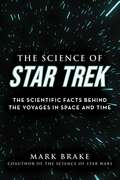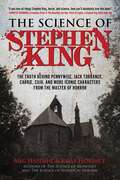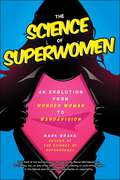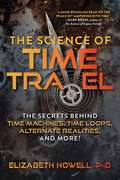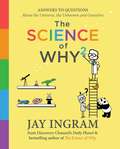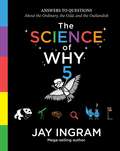- Table View
- List View
The Science of James Bond: The Super-Villains, Tech, and Spy-Craft Behind the Film and Fiction (The Science of Series)
by Mark BrakeSpy-Fi Culture with a License to KillFrom Sean Connery to Daniel Craig, James Bond is the highest-grossing movie franchise of all time. Out-grossing Star Wars, Harry Potter, and the Marvel Cinematic Universe, the world&’s most iconic and international secret agent has a shelf life of almost six decades, from Dr. No to Spectre. As nuclear missile threats are replaced by a series of subtler threats in a globalized and digital world, Bond is with us still.In The Science of James Bond, we recognize the Bond franchise as a unique genre: spy-fi. A genre of film and fiction that fuses spy fiction with science fiction. We look at Bond&’s obsessions with super-villains, the future, and world domination or destruction. And we take a peek under the hood of trends in science and tech, often in the form of gadgets and spy devices in chapters such as:Goldfinger: Man Has Achieved Miracles in All Fields but Crime!You Only Live Twice: The Race to Conquer SpaceLive and Let Die: Full Throttle: Bond and the CarSkyfall: The Science of CyberterrorismAnd more!This is the only James Bond companion that looks at the film and fiction in such a spy-fi way, taking in weapon wizards, the chemistry of death, threads of nuclear paranoia, and Bond baddies&’ obsession with the master race!
The Science of Jurassic World: The Dinosaur Facts Behind the Films (The Science of)
by Mark Brake Jon ChaseA tale of some of the most amazing creatures ever to grace this tiny planet—unearth how the science fiction of the Jurassic World franchise inspired the evolution of dinosaur science. It all began in 1993. Jurassic Park was a movie landmark in the development of computer-generated imagery and animatronic visual effects. Jurassic Park became the highest-grossing movie of that year, and the highest-grossing film ever at the time, a record held until the 1997 release of Titanic. The field of dinosaur science has blossomed by leaps and bounds and branched out in recent years, in no small part to this iconic movie series. In The Science of Jurassic World, we experience the amazing story of the birth of the dinosaurs, how they evolved to world dominance, how some became gargantuan in size, how others grew wings and flew, and how the rest of them met an untimely end. Chapters include: How did Jurassic Park transform dinosaur science?Was Dr. Alan Grant&’s job a walk in the park?What&’s with the giant dinosaur poop?When will we clone dinosaurs?And so much more! Discover how some of cinema&’s most incredible creations do justice to the jaw-dropping evolution of these fantastic creatures.
The Science of Living (Psychology Revivals)
by Alfred AdlerOriginally published in 1930 The Science of Living looks at Individual Psychology as a science. Adler discusses the various elements of Individual Psychology and its application to everyday life: including the inferiority complex, the superiority complex and other social aspects, such as, love and marriage, sex and sexuality, children and their education. This is an important book in the history of psychoanalysis and Adlerian therapy.
The Science of Michael Crichton: An Unauthorized Exploration into the Real Science Behind the Fictional Worlds of Michael Crichton
by Michael CrichtonMichael Crichton’s thrillers traverse the cutting edge of science and then push the envelope. How realistic are his takes on subjects ranging from dinosaur cloning to global warming, nanotechnology to time travel, animal behavior to human genetics? The Science of Michael Crichton gathers essays from prominent experts that examine the amazing inventions of Crichton’s books and lift up the hood, revealing the science underneath—exploring which Crichton imaginings are feasible and which are just plain impossible. Computer science innovator Ray Kurzweil looks at how virtual reality is portrayed in The Terminal Man; anthropologist Ian Tattersall takes on Crichton’s depiction of Neanderthals in Eaters of the Dead; meteorologist David Lawrence discusses global warming in State of Fear—and much more, in a fascinating volume that separates the science from the fiction.
The Science of Minecraft: The Real Science Behind the Crafting, Mining, Biomes, and More! (The Science of)
by James DaleyDiscover the science behind the Minecraft phenomenon! With more than 200 million units sold, Minecraft is the undisputed bestselling video game of all time. Since it first launched, the game&’s groundbreaking mix of open-world exploration, creative construction, and stunningly simple graphics have kept players old and young alike constantly coming back to explore, survive, and create. Even now, a decade after its release, there are still more than 126 million active users supporting not only the game, but an entire universe of movies, comics, conventions, classes, and so much more. A perfect gift for any Minecraft enthusiast, The Science of Minecraft explores some of the game&’s most popular topics and gameplay mechanics, including: ResourcesMiningConstructionCraftingMechanical DevicesBiomesWeapons and ArmorAnd So Much More This book explains how the game&’s famous construction mechanics would function in real life, what its many natural resources share (or do not share) with their terrestrial counterparts, and what the deal is with the mysterious alternative dimensions of the Nether and the End. Whether you&’re a fan of creative or survival mode, The Science of Minecraft will illuminate and inspire you with the scientific realities behind this iconic game.
The Science of Mom: A Research-Based Guide to Your Baby's First Year
by Alice CallahanThe Science of Mom blogger makes sense of research studies for new mothers.It seems like every time a new mother turns on her computer, radio, or television, she is greeted with news of yet another scientific study about infancy. Ignoring good information isn’t the right course, but just how does one tell the difference between solid studies, preliminary results, and snake oil? In this friendly guide through the science of infancy, Science of Mom blogger and PhD scientist Alice Callahan explains how non-scientist mothers can learn the difference between hype and evidence. Readers of Alice’s blog have come to trust her balanced approach, which explains the science that lies behind headlines. The Science of Mom is a fascinating, eye-opening, and extremely informative exploration of the topics that generate discussion and debate in the media and among parents. From breastfeeding to vaccines to sleep, Alice’s advice will help you make smart choices so that you can relax and enjoy your baby.
The Science of Mom: A Research-Based Guide to Your Baby's First Year
by Alice CallahanNow updated! The new edition of this best-selling guide uses science to tackle some of the most important decisions facing new parents—from sleep training and vaccinations to breastfeeding and baby food.Is cosleeping safe? How important is breastfeeding? Are food allergies preventable? Should we be worried about the aluminum in vaccines? Searching for answers to these tough parenting questions can yield a deluge of conflicting advice. In this revised and expanded edition of The Science of Mom, Alice Callahan, a science writer whose work appears in the New York Times and the Washington Post, recognizes that families must make their own decisions and gives parents the tools to evaluate the evidence for themselves. Sharing the latest scientific research on raising healthy babies, she covers topics like the microbiome, attachment, vaccine safety, pacifiers, allergies, increasing breast milk production, and choosing an infant formula.
The Science of Monsters: The Truth about Zombies, Witches, Werewolves, Vampires, and Other Legendary Creatures
by Meg Hafdahl Kelly FlorenceA must-have for any fan of horror and fantasy movies—Night of the Living Dead, A Nightmare on Elm Street, The Shining (Stephen King), and so many more! If you love film that scares, and want to believe that zombies, vampires, and other deadly and terrifying creatures could be real, let Meg Hafdahl and Kelly Florence, the women behind the Horror Rewind podcast called “the best horror film podcast out there” by Film Daddy, take you to the world where horror and science meet. How would a zombie really decompose in Night of the Living Dead?Are there instances of shape shifting in nature like in The Wolf Man?What is the science behind the night terrors that inspired the creation of Freddy Krueger?Is there scientific data supporting ghost detection like the tools used in Poltergeist?What is the psychological drive that compels cannibals like Hannibal Lecter?How does modern medicine and therapy differ from what would have been offered to Norman Bates in 1960?How are subliminal messages related to propaganda or brainwashing like in The Ring?What would the scientific explanation be for witches possessing people like in Carrie?Was The Blair Witch Project based on any real or imagined creature that came before?”And so much more! Gothic media moguls Meg Hafdahl and Kelly Florence revisit the films from their childhood to discover the science behind the fear. Join Kelly and Meg as they unravel the medical mysteries and scientific marvels that inspired the creation of famous monsters like Nosferatu, Norman Bates, Dracula, Frankenstein, and many more. An approachable and frightfully fun examination of what goes bump in the night, The Science of Monsters will thrill every horror fan.
The Science of Parenting: How Today’s Brain Research Can Help You Raise Happy, Emotionally Balanced Childr
by Margot SunderlandBacked by the most up-to-date scientific research, The Science of Parenting, 2nd Edition provides evidence-based parenting advice about how you should care for your child, with practical strategies from birth to 12 years of age. Child psychotherapist Dr. Margot Sunderland has more than 30 years' experience that she brings to this internationally-acclaimed guide, and she provides numerous case studies to relate the science to real life.From separations and time apart to forms of discipline to the latest thinking on screen time, this guide traces the direct effect of different parenting practices on your child's brain. Summaries at the end of every chapter provide key takeaways and make action points simple and clear so you can begin to implement them immediately.As a professional who works with families, Dr. Sunderland is attuned to the struggle of parents juggling lives at work and at home. This second edition of The Science of Parenting provides newly added, invaluable advice on making the most of your time with your child, so that you can forge a strong bond and have a positive relationship.The Science of Parenting remains the greatest work on what science can teach us about parenting and the remarkable effects of love, nurture, and play on a child's development.
The Science of People and Office Design: Planning for Thinking, Discussing and Achieving
by Sally Augustin Nigel OselandThe Science of People and Office Design: Planning for Thinking, Discussing and Achieving has been written for practitioners who would like to apply evidence-based and human-centric design principles to office and workplace design. Practitioner-researcher disconnects often arise due to a lack of meaningful connection between their professional worlds. This book seeks to rectify this disconnect and make it clear that research can significantly affect the likelihood that design projects achieve the objectives outlined in their briefs, and that practitioners need to have a real influence on research conducted.The book consists of 16 chapters,each grouped into three major sections, with an overview chapter and a conclusion drawn together by the editors. Each chapter addresses a real-world workplace design-related issue. The first part of each chapter presents the editors' overview of the problem in practice and the objectives that must be achieved via design solutions. The second portion of each chapter presents peer-reviewed research related to the chapter’s topic, written by a researcher focused on practical issues. The final part of each chapter is written by a workplace design practitioner and details their efforts to resolve the section’s real-world workplace design-related concern by applying relevant peer-reviewed research.The book is aimed at professionals working in business, interior design, architecture, surveying, facilities management, building services engineering, human resources and psychology who are key stakeholders in the design and delivery of modern office spaces. Postgraduates studying design, architecture, engineering, facilities management, environmental psychology and wellbeing will also find the book useful.
The Science of Psychology: An Appreciative View, 6th Edition
by Laura A. KingFocusing on why things go right, The Science of Psychology: An Appreciative View helps students understand and appreciate psychology as a science and as an integrated whole. Informed by student data, the program extends these themes and enhances their pedagogical value by helping students through topics they find the most challenging and offering learning resources to master them. With a deep integration of cultural diversity, the text offers a “Guide to Diversity, Equity, and Inclusion” in the Preface, providing a chapter-by-chapter list of topics involving DEI issues and research. When paired with Connect, students will also benefit from Thematic Relevancy Modules (brief, thought-provoking modules tied to the APA's IPI Student Learning Outcomes), Interactivities and Application-Based-Activities, Psych-at-Work videos (interviews with real people), the new and unique Immersive Brain, and more innovative resources to help further prepare them to be successful in this course.
The Science of Science Fiction: The Influence of Film and Fiction on the Science and Culture of Our Times
by Mark BrakeWe are the first generation to live in a science fiction world.Media headlines declare this the age of automation. The TV talks about the coming revolution of the robot, tweets tell tales of jets that will ferry travelers to the edge of space, and social media reports that the first human to live for a thousand years has already been born. The science we do, the movies we watch, and the culture we consume is the stuff of fiction that became fact, the future imagined in our past—the future we now inhabit.The Science of Science Fiction is the story of how science fiction shaped our world. No longer a subculture, science fiction has moved into the mainstream with the advent of the information age it helped realize. Explore how science fiction has driven science, with topics that include:Guardians of the Galaxy: Is Space Full of Extraterrestrials?Jacking In: Will the Future Be Like Ready Player One?Mad Max: Is Society Running down into Chaos?The Internet: Will Humans Tire of Mere Reality?Blade Runner 2049: When Will We Engineer Human Lookalikes?And many more! This book will open your eyes to the way science fiction helped us dream of things to come, forced us to explore the nature and limits of our own reality, and aided us in building the future we now inhabit.
The Science of Serial Killers: The Truth Behind Ted Bundy, Lizzie Borden, Jack the Ripper, and Other Notorious Murderers of Cinematic Legend (The Science of)
by Meg Hafdahl Kelly FlorenceDiscover the real-life inspirations behind history&’s most infamous serial killers: John Wayne Gacy, Jeffrey Dahmer, Charles Manson, and so many more. Gothic media moguls Kelly Florence and Meg Hafdahl, authors of The Science of Monsters, The Science of Women in Horror, and The Science of Stephen King, and co-hosts of the Horror Rewind podcast called &“the best horror film podcast out there&” by Film Daddy, present a guide to the serial killers who inspired the movies and media we all know and love. Delve into the brutal truth behind horror&’s secret: many monsters portrayed on the silver screen are based on true murderers. Uncover the truth behind the real monsters of horror, answering such questions as: What is the science behind serial killers&’ motivations like Ted Bundy and John Wayne Gacy? How did detectives discover the identities of criminals like the Boston Strangler and the BTK Strangler?Has science made it possible to unmask Jack the Ripper and the Zodiac Killer? What is the science behind female versus male serial killers? Through interviews, film analysis, and bone-chilling discoveries, join Kelly and Meg as they learn about the horrors of true crime through the decades.
The Science of Sherlock: The Forensic Facts Behind the Fiction (The Science of)
by Mark BrakeAn essential read for the legions of Sherlockians about the globe. Sherlock Holmes is the world&’s greatest-ever consulting detective. The huge popularity of Sir Arthur Conan Doyle&’s fictional creation, and his sixty stories, made Sherlock one of the most famous characters of Victorian London. All evidence of Sherlock&’s fan adoration has lasted almost one and a half centuries through many adaptations. There is Sherlock fan fiction in China, Sherlock manga in Japan, and tribute pop songs in Korea. Guinness World Records awarded Sherlock Holmes the title of most portrayed literary human character in film and television thanks to the popular Sherlock Holmes movies starring Robert Downey Jr., series like Elementary starring Lucy Liu, Sherlock starring Benedict Cumberbatch, and so much more. Sherlock&’s enduring appeal shows that his detective talents are as compelling today as they were in the days of Conan Doyle. The Science of Sherlock gives you an in-depth look at the science behind the cases Sherlock cracked in those Ripper streets of old.
The Science of Spice: Understand Flavor Connections and Revolutionize Your Cooking
by Dr. Stuart FarrimondTransform your dishes from bland and boring to punchy and flavorsome with this definitive guide to spices.It&’s time to spice up your home cooking!Taking the periodic table of spices as a starting point, this adventurous recipe book explores the science behind the art of making incredible spice blends to help you release the flavor in your dishes. Discover a spice book like no other from TV personality, food scientist and bestselling author, Dr Stuart Farrimond. Sure to get your tastebuds tingling, you can explore: - 52 exciting recipes from around the world which showcase each spice blend- An explanation of what spices are and how they're produced- Which countries favor which spices and a bit of the history behind it- Dozens of spice blends you can make and what you can use it for- A reference guide where you can conveniently look up each spice to understand how to use it- Various color-coded charts to help you learn the chemical compound that make up the flavors- Instructions on how to design your own spice blends- Beautiful photographs of spices and foodGreat cooking goes beyond following a recipe - it's knowing how to use the right combination of spices and herbs to get the greatest possible flavor from your dishes. From learning how the flavor compounds within spices work together to exploring the world's top spices, this is the perfect cookbook for curious cooks and adventurous foodies. Whether you&’re a fan of spice seeking to experiment with new flavor combinations, or simply a beginner-level home cook looking to advance your knowledge on all things spice related, this is a must-have volume also doubling up as a great coffee table book for the whole family to love.If you've ever wondered why some spices taste stronger than others or how to make your own personal garam masala, The Science of Spice has all the answers! Discover how to use spices for cooking to become more creative in the kitchen, and explore the multiple ways that spices can endlessly heighten your eating experience.At DK, we believe in the power of discovery. So why stop there? This series from DK is designed to help you perfect your cooking with practical instruction - and the science behind it. There are more cookbooks to discover from The Science of... series giving you the essentials to cook up a storm! Find the answers to your everyday cooking questions and get more out of your recipes with The Science of Cooking, paired together they make the ideal cookery gifts for your food-loving friends too!
The Science of Star Trek: The Scientific Facts Behind the Voyages in Space and Time (The Science of)
by Mark BrakeBoldly go where no man has gone before and discover the real science behind the cyborgs, starships, aliens, and antimatter of the Star Trek galaxy.Star Trek is one of the highest-grossing media franchises of all time. It has changed our cultural landscape in so many ways since it first aired in 1966. The franchise has generated billions of dollars in revenue, leading to a wide range of spin-off games, novels, toys, and comics. Star Trek is noted for its social science, too, with its progressive civil rights stances and its celebration of future diversity that began with The Original Series, one of television's first multiracial casts. The Science of Star Trek explores one of the greatest science-fiction universes ever created and showcases the visionary tech that inspired and influenced the real-world science of today. The perfect Star Trek gift for fans of the franchise, this book addresses many unanswered, burning questions, including: What can Star Trek tell us about aliens in our Milky Way?How has Star Trek influenced space culture?What can Star Trek tell us about planet hunting?What Star Trek machines came true?When will we boldly go? Learn more about one of our favorite modern epics with The Science of Star Trek!
The Science of Stephen King: The Truth Behind Pennywise, Jack Torrance, Carrie, Cujo, and More Iconic Characters from the Master of Horror (The Science of Series)
by Meg Hafdahl Kelly FlorenceUncover the theories behind the Master of Horror's macabre tales: It, The Shining, Carrie, Cujo, Misery, Pet Semetary, and so much more! Gothic media moguls Meg Hafdahl and Kelly Florence, authors of The Science of Monsters and The Science of Women in Horror, and co-hosts of the Horror Rewind podcast called &“the best horror film podcast out there&” by Film Daddy, present a guide to the Stephen King stories and characters we all know and love. Through interviews, literary and film analysis, and bone-chilling discoveries, The Science of Stephen King delves into the uniquely horrific Stephen King universe to uncover the science behind the legendary novels that have become an integral part of modern pop culture, answering such questions as: What is the science behind time travel and parallel universes like in The Dark Tower series and 11/22/63?How does lack of sleep affect the human body like in Insomnia?Is it possible for horrific creatures to exist like in Nightshift?What is the science behind curses and legends like in Dreamcatcher and Thinner? Join Kelly and Meg as they learn if we all really do float down here!
The Science of Strong Women: The True Stories Behind Your Favorite Fictional Feminists (The Science of)
by Rhiannon LeeDiscover all there is to know about strong women in fiction: Hermione Granger, Wonder Woman, Princess Leia, and more!A strong woman is not just a badass lady who solves her problems with a high kick and a sassy comeback, all the while looking fabulous in a cape (although the cape is a plus!). A strong woman is a pioneer for bravery, intelligence, determination, and social justice for all.Compelling, humorous, and brilliantly illustrated in equal measures, The Science of Strong Women showcases a collection of fifty fantastic fictional feminists we all know and love. Through media analysis and awe-inspiring discoveries, this inspirational guide delves deeper into female-forward fiction and features a truly diverse collection of strong women including: June OsborneStar CarterKatniss EverdeenElizabeth BennetÉowynJo MarchBuffy SummersAnd many more Here&’s to strong women. May we know them, may we be them, and may we learn from them with The Science of Strong Women.
The Science of Superwomen: An Evolution from Wonder Woman to WandaVision (The Science of)
by Mark BrakeCelebrate the rise of superwomen and discover the science behind the abilities of Wonder Woman, Scarlet Witch, Black Widow, Catwoman, and more! Superhero fiction has been with us for almost a century; high-octane tales crammed with concepts and contrasting themes, from superpowers and the post-human, to masked vigilantes and immortality. In that time, superwomen have evolved from comic book caricatures (created by men, for men) to stronger representations of female power. The Science of Superwomen looks at this evolution, from its hypersexualized origins to today&’s more nuanced diversity. Focusing on characters from Star Wars and X-Men, as well as the likes of Wonder Woman, Batgirl, Captain Marvel, Harley Quinn, Wednesday Addams, Doctor Who, and Buffy the Vampire Slayer, The Science of Superwomen explores the relationship between superhero film and fiction and the underlying science of our ever-evolving universe.
The Science of The Beatles: The Technology and Theory Behind the Music and Lyrics (The Science of)
by Mark Brake Dr. Jeff BrakeAn In-Depth Analysis of The Beatles' Music and the Theory, Techniques, and Technology That Made It Possible When people look back in two hundred years time at our culture, whose music will have survived from today? Who will be our equivalent of Bach, Mozart, and Beethoven? The big story of contemporary popular music has been The Beatles. They were the chief architects of the fusion of classical and popular music to create a new musical mainstream. From the time we humans first made our art, music and technology have been inseparable. And that symbiotic relationship has never been so excitingly orchestrated than with the musical history of The Beatles. They absorbed many other styles around them in an extraordinary and unprecedented melting pot of music. And they embraced new technologies with enthusiasm and imagination. As pioneers of recording tech and artistic presentation, making American music with a British twist, The Beatles revolutionized many aspects of music tech, and became leaders of the era&’s youth and sociocultural movements. Their music was both genuinely sophisticated and hugely popular. For a generation, they were the most important composers in the world, and became the most influential band of all time. Putting the band&’s thirteen legendary studio albums under a microscope, The Science of The Beatles looks at the science, poetry, and raw-power in the music that started a revolution.
The Science of The Mandalorian: The Anatomy of a Space Western (The Science of)
by Mark BrakeTake a trip beyond this Earth to explore the myths of The Mandalorian and uncover the anatomy of the newest space western in the Star Wars Universe.Star Wars dominates the film world. The combined box office revenue of the Star Wars movies equates to over $10 billion, making it the second highest-grossing film franchise of all time. But this franchise is no blaster from the past. Its fantastically successful films have now been followed by multiple television series set in that same galaxy far, far away. The franchise&’s flagship television series, and likely the firmest fan favorite for some time to come, is The Mandalorian. Tracing the tale of the titular bounty hunter, traveling across the furthest reaches of that mythic galaxy, The Mandalorian has been greatly praised and highly acclaimed for creating characters with gravitas and originality, worlds with depth and impact, resulting in some of the best Star Wars content ever. Even though it&’s set in deep space, The Mandalorian has as much in common with Western movies as it does with science fiction. Saloons. Bandits. &“Gun&” duels. Bounty hunters. Outlaws with a price on their heads. Space exploration as a &“final frontier.&” And a wild hero who doesn&’t quite belong in a lawless part of the Galaxy after the fall of the Empire.The Science of The Mandalorian takes you on a badass journey with a mysterious, lone gunfighter in the outer reaches of the galaxy, where your beskar armor will protect you from many things, but not the sight of a small, green, carnivorous humanoid with big black eyes and mysterious powers. This is the way.
The Science of Time Travel: The Secrets Behind Time Machines, Time Loops, Alternate Realities, and More!
by Elizabeth HowellTravel back in time with Doctor Who, the Terminator, the X-Men, and all your favorite time travelers! Science fiction is the perfect window into the possibilities and perils of time travel. What would happen if you went back in time and killed your own grandparent? If you knew how to stop a presidential assassination, would time travel allow you to make your wish come true? Can we use time travel as a tool to escape the destiny of our future or mistakes of the past? The Science of Time Travel explores time travel through your favorite science-fiction franchises, from the classic time travel paradoxes of Star Trek to the universe-crossing shenanigans of Doctor Who. Discover the real science behind questions such as: Can time travel really erase our past regrets like in A Christmas Carol?Is it worth killing people in the past to prevent a horrible future like in Terminator?What can we learn from living the same day over and over again like in Groundhog Day?Could time travel destroy our right to privacy like in Deja Vu?And so much more! It's time to fire up the DeLorean to 88 mph, jump into the TARDIS hiding in plain sight, or warp space with the USS Enterprise to explore what time travel means for us.
The Science of Why 2: Answers to Questions About the Universe, the Unknown, and Ourselves
by Jay IngramAn all-new volume of science questions to delight, entertain, and inform readers of all ages, from bestselling author Jay Ingram.Bestselling author and commentator Jay Ingram is back to explain the magic and mysteries of the world around us. Jay takes readers on a tour of the universe, exploring wonders big and small. From the farthest reaches of space to the most perplexing historical riddles to the marvels of who we are and what we’re made of, Jay answers the important questions, such as: What’s inside a black hole? Will machines ever learn to feel? How much pee is in the average swimming pool? Because who hasn’t wondered whether we’re living in a computer simulation? Or whether Atlantis existed? Or why cats always land on their feet? With wit, wisdom, and whimsical illustrations, The Science of Why 2 will delight readers of all ages with the answers to all these questions and more. Full of fun science facts (and fictions), this is the book that everyone’s inner science geek needs to read.
The Science of Why, Volume 4: Answers to Questions About Science Facts, Fables, and Phenomena (The Science of Why series #4)
by Jay IngramBack by popular demand: a brand-new volume of science queries, quirks, and quandaries in the mega-bestselling Science of Why series, sure to enlighten and entertain readers of all ages.Have you ever wondered why we close our eyes when we sneeze? Or how far underground things can live? Or if there&’s a way to choose the fastest lineup at the grocery store? Yes? Then fasten your seat belts! Bestselling author Jay Ingram is here to take you on a rollercoaster ride through science&’s most perplexing puzzles. From the age-old mysteries that have fascinated us to the pressing unknowns about our future and all the everyday wonderings in-between, Jay answers questions that confound and dumbfound, such as: Why do zebras have stripes? How many universes might there be? Can we live for 200 years? ...along with everything you ever wanted to know about alien civilizations, photographic memories, nanobots, poop, and (conveniently) toilet paper. Bursting with laugh-out-loud illustrations, jaw-dropping marvels, and head-scratching science fictions, The Science of Why, Volume 4 will give readers of all stripes a real thrill.
The Science of Why, Volume 5: Answers to Questions About the Ordinary, the Odd, and the Outlandish (The Science of Why series #5)
by Jay IngramChock-full of peculiar puzzles, mind-bending mythbusters, and quirky questions, the fifth pop science book in the bestselling Science of Why series is perfect for anyone curious about the weird and wondrous world we live in.Have you ever wondered if octopuses are from outer space? What Mexican jumping beans are? Or if banana peels are really slippery? If questions like these are keeping you up at night, you can rest easy. Bestselling author Jay Ingram is here to answer all the whimsical and whacky wonderings that have baffled people since the dawn of time. From our bodies to our pets (and other beasts) to the natural world around us, Jay tackles science topics big and small, such as: Did dinosaurs sit on their eggs? What is our funny bone? Is there a specific muscle that makes dogs cute? Because who hasn&’t pondered whether plants have feelings? Or if Robin Hood was a real person? Or what humans will look like in the future? Teeming with amusing answers to bemusing questions—and handy and hilarious illustrations—this latest volume separates fact from fiction, lesson from legend, and myth from marvel. Endlessly illuminating and entertaining, The Science of Why, Volume 5 is five times the fun for new and old readers of the series.
